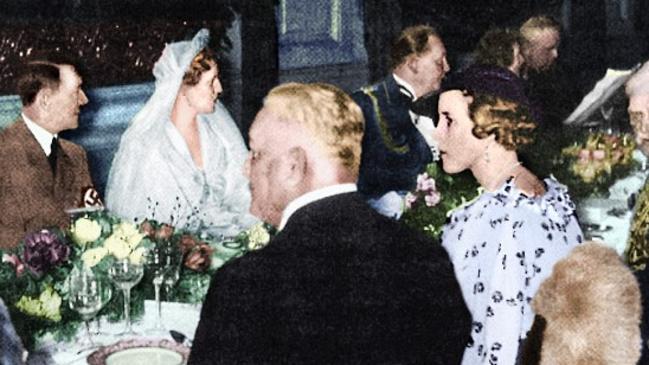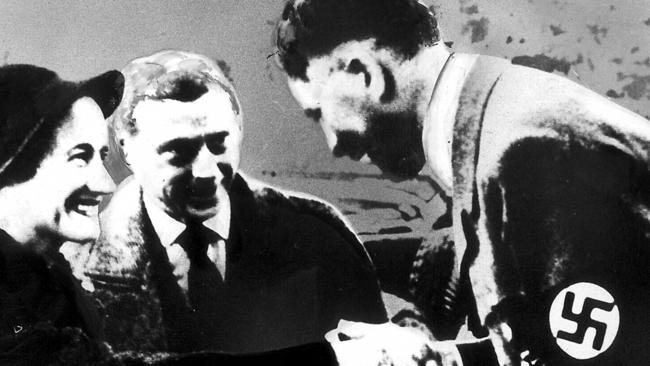Nazis cast murky shadow over royals
The German connection that has left Queen Elizabeth less than amused by 80-year-old images showing her making a playful Nazi salute has been a source of embarrassment to English royals for a century.

Today in History
Don't miss out on the headlines from Today in History. Followed categories will be added to My News.
The German connection that has left Queen Elizabeth less than amused by 80-year-old images showing her making a playful Nazi salute has been a source of embarrassment to English royals for a century.
With troops bogged down in World War I trenches, Britain was awash with anti-German sentiment when her grandfather George V whitewashed his German ancestry by changing the name of the British royal house from Saxe-Coburg-Gotha to Windsor.
On June 27, 1917, the satirical magazine Punch greeted George’s decree with a cartoon under the title, A Good Riddance, writing “The King has done a popular act in abolishing the German titles held by members of His Majesty’s family.” The German royal titles held by British royals came from George’s grandfather Prince Albert, husband of Queen Victoria, who had belonged to the House of Saxe-Coburg-Gotha. Germany’s wartime leader Kaiser Wilhelm II was another of Queen Victoria’s grandsons, making him George’s cousin. George’s wife, although born in London, was Mary of Teck from the German Rhineland house of Baden-Württemberg.
When the Queen, then Princess Elizabeth, married in 1947, her husband Anglicised his royal heritage by taking the name Mountbatten. Prince Philip’s mother, Princess Alice of Battenberg, was born to Prince Louis of Battenberg and Princess Victoria of Hesse-by-Rhine, both based in central Germany.
Even before the Queen’s uncle Bertie, who ruled briefly as Edward VIII before abdicating in 1936 — and shown in the Nazi salute photograph with the young princess — was snapped meeting Adolf Hitler in Munich in 1937, Philip’s suitability as the husband of a British royal was questioned because of his family’s Nazi links.

Philip had spent much of his youth in Germany, where three of his sisters, Sophie, Cecile and Margarita, married German princes who became leading Nazis.
Photographs of a 16-year-old Prince Philip walking alongside Nazi officials in Darmstadt in 1937 were published by American historian Jonathan Petropoulos in Royals And The Reich in 2006.
Philip was flanked by relatives in SS and Brownshirt uniforms when he attended the funeral of his elder sister Cecile, who had married Georg Donatus, grand duke of Hesse-by-Rhine, a great-grandson of Queen Victoria.
At the funeral Philip marched with his surviving German brothers-in-law, Prince Christoph of Hesse, husband of Philip’s youngest sister, Sophie, in his SS garb and Christoph’s brother, Prince Philipp of Hesse, wearing the SA brown shirt. Philip’s uncle Lord Louis Mountbatten followed just behind in British naval dress. While Hitler and propaganda chief Joseph Goebbels sent messages of sympathy, Storm Troopers chief Hermann Goering, a long-time family friend, attended in person.
Historians suspect royal archives held in Windsor Castle’s Round Tower contain large volumes of correspondence between members of the British royal family and Nazi politicians and aristocrats, although some suggest much of the correspondence was likely destroyed after World War II to protect royal reputations.
Royals And The Reich also shows Philip’s youngest sister Sophie sitting opposite Hitler at the 1935 wedding of Hermann and Emmy Goering. Her husband Prince Christoph joined the Nazi Party in 1932 after Goering encouraged them to invite Hitler to lunch, and later became chief of Goering’s secret intelligence service.
It is suggested Hitler enjoyed the presence of German nobility at Nazi functions to lend his cause legitimacy. He sent contradictory messages on the role of royalty under the Third Reich, promising minor royals that he intended restoring monarchal government. But he also quipped that the best part of the Socialist Democrat platform was their “antimonarchy stance”.
Philip’s sister Margarita had married Gottfried, Prince of Hohenlohe-Langenburg. As a Nazi Party member, he was an Army commander during the 1938 occupation of Austria. Documents also revealed Nazi Foreign Policy Office head Alfred Rosenberg in 1934 “discussed drawing closer to the royal English house” with Gottfried, who in July 1944 joined a plot by disenchanted aristocrats to assassinate Hitler, leading to his dismissal from the army.
The plot to kidnap Edward
World War II records suggest the Nazis plotted unsuccessfully to kidnap Edward VIII in 1940 and reinstall him as king if Germany invaded Britain.
With war over in 1945, England dispatched spy Anthony Blunt on a secret mission to Germany with royal librarian Owen Morshead to “repatriate” papers that showed how various members of the British royal family had been involved with the Nazis. Blunt and Morshead snatched two boxes of documents from the Hesse family ancestral home, Schloss Kronberg, outside Frankfurt.
Originally published as Nazis cast murky shadow over royals


